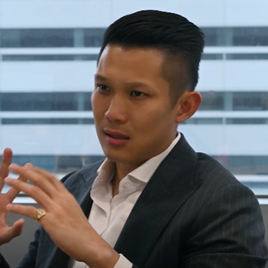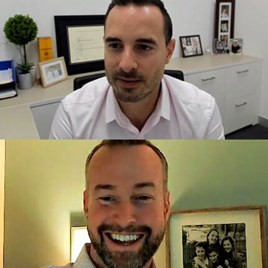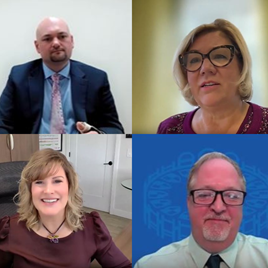Nov 01 2023 / Round the Table Magazine
Retirement planning: It’s about more than just money
Topics Covered
Entering retirement is among the biggest transitions many people will go through in their lives, and while the adjustment can be an exciting new chapter, it can also be one of the most difficult — even for those who are financially prepared. As an advisor, it’s an opportunity to not only help clients navigate their new reality, but also help you build stronger bonds and capture more referrals, according to MDRT members who focus on pre-retirement planning.
Clay Gillespie, CFP, CLU, a 22-year MDRT member from Vancouver, British Columbia, Canada and MDRT Secretary, said retirement can be one of the biggest stressors in a client’s life, particularly those whose self-worth is tied to their livelihood.
“You need to tell them this and guide them through the process because they frequently think everyone is happy and excited about retirement,” he said. “It’s important to have this discussion to make sure your clients understand that retirement is a journey and not a destination.”
The go-go years
Gillespie said the first two years of retirement are typically the most expensive, and it’s usually not until around year three that clients begin to settle into their new paradigm. The first few years, which Gillespie refers to as the “go-go years,” are often used to address interests and opportunities that were delayed in the final years of their employment.
This can include big goals like renovating the home and traveling the world or something as simple as reimagining their home garden. The projects retirees choose to tackle in the first couple of years are frequently more expensive and will not be repeated, Gillespie explained.
Advisors can add value to clients’ lives by helping them develop what that life will look like, rather than focusing exclusively on financial affairs, he said. It’s important for advisors to realize that even in retirement, clients’ income needs will change dramatically over time, and making more funds available is often necessary in those first few years, according to Gillespie.
“The industry is doing a disservice to new retirees when advisors assume their clients need a stable income adjusted for inflation throughout their retirement years,” he said. “If we run the analysis, assuming a steady net spendable income (after taxes and inflation) through their retirement years, we are not allowing them to spend more money in their early go-go years when they are healthier and have more energy.”
In his practice, Gillespie said he’s found clients typically only need to increase their income every three to four years, rather than every year, and by the time they reach what he calls the “slow-go years” — when they are less active — they may never need to increase their income again.
“We need to give them guideposts on how much income they can generate in each stage of retirement; it is our job to give them that answer,” he said.
We need to give them guideposts on how much income they can generate in each stage of retirement; it is our job to give them that answer
— Clay Gillespie
Winging it won’t cut it
Helping clients maneuver their way through the non-financial part of retirement is key to helping them achieve their dreams, according to Juli Y. McNeely, CFP, CLU, a 16-year MDRT member from Spencer, Wisconsin, USA. “It is astounding to me how many clients haven’t had these deeper conversations and believe they will just ‘wing it’ when they get to retirement,” she said.
McNeely and her team have developed a list of talking points for clients to consider that are based on the MDRT Whole Person concept. She gives them the option to review the retirement planning checklist with an advisor or on their own. The objective is to get clients to open up about their goals for the future, she said.
Her pre-retirement talking points include the following:
- What hobbies and interests will you take into retirement, or will you try something new?
- When you’re no longer working, how will you connect with friends who are not retired yet or have already embarked on their retirement life?
- How will you mitigate retirement risks like a major health issue or long-term care for you, or taking care
of aging parents or dependent children? - Do you have a good CPA/income tax preparer to deal with your tax obligations during retirement?
- Are your legal documents and beneficiary designations in order? What are your plans for gifting and charitable contributions now and when you die?
- What travel destinations are on your bucket list?
- Is there an encore career in you? What will you do if your spouse is still working?
- How do you want to be remembered? Do you want to bless those who are important to you?
- Will you connect with family and friends more?
McNeely’s approach touches on possible retirement pitfalls that financial planning fails to address, such as managing time with family. “Do you need to put some parameters or boundaries around that time?” she asks clients.
Retirement realities
Gillespie also works with clients to explore some of the emotional risks they may face in retirement, like boredom, loss of identity and no longer feeling of value. He noted that post-retirement divorce is also common.
These issues can be even more pronounced for those considering early retirement, he said. “When you retire early and you haven’t developed a retirement lifestyle, all your friends might still be working or have developed their own retirement lifestyle and are not around,” he said.
Back to basics
While much of McNeely’s questioning focuses on interpersonal aspirations, she also talks with them about taxes, potential health risks down the road, estate planning and their overall financial future.
“Making sure our clients have a good CPA or tax provider is essential,” she said. “We also want to make sure we are in alignment with the tax-reducing strategies we utilize.”
She said the talking points aim to get a conversation started about issues that are often overlooked by clients who are still busy in their working life.
“Discussing the gaps in their financial picture, as well as making sure they’re in alignment with their partner, is critical,” she said. “Making sure they know how they’ll handle overspending and underspending, as well as gifting and charitable plans, will also be beneficial to discuss before they get too far into retirement.”
Gillespie similarly said he makes a point of discussing the risks clients may face in retirement, such as inflation, longevity, market volatility, health risks and more. “I tell them, ‘You only retire once, but I help people retire every day, so I’ve seen the good and the bad, both emotionally and financially.’”
He said advisors should stress that any concerns or confusion they may have in the process are normal and to be expected.
Good for business
The emotional heavy lifting that goes into ushering clients into retirement will help to ensure they make better decisions to achieve their goals, and successfully tending to their needs can help strengthen an advisor’s business, according to McNeely.
“Painting a picture for your clients and then creating a road map to guide them through these conversations and decisions will be welcomed, and it will tie them closer to your business,” she said.
The practice of walking them through the financial, as well as the emotional, issues they may face has helped build her book of clients, she said.
“We have experienced a significant number of referrals because other advisors aren’t doing this with their clients,” she said. “We are all great at helping our clients prepare financially for retirement, but could we be doing more? I believe we are perfectly positioned to ensure our clients have a robust personal retirement readiness plan, so when you ask your client, ‘Are you ready?’ they will be able to answer yes.”




![Elevating your financial advisory journey: how the right mentor can propel your success to new heights [Surabhi Chaudhary]](https://www.mdrt.org/globalassets/digizuite/32702-en-updated_-india_video-interview_surabhi-chaudhari-thumbnail.png?height=268&crop=0,0,268,268)

![Beyond finance: Individuals outside the financial profession every financial advisor should learn from [Nirmal Debnath]](https://www.mdrt.org/globalassets/digizuite/32634-en-india_written-interview_nirmal-debnath-thumbnail.jpeg?height=268&crop=0,0,268,268)
![How to tailor financial advice to fit the unique needs and goals of your clients [Merryl Baptista]](https://www.mdrt.org/globalassets/digizuite/32635-en-india_written-interview_merryl-baptista-thumbnail.jpeg?height=268&crop=0,0,268,268)
![Anticipating the financial needs of Gen Z clients and advising prospects towards adequate insurance cover [Komal Atal]](https://www.mdrt.org/globalassets/digizuite/32632-en-india_written-interview_komal-attal-thumbnail.jpeg?height=268&crop=0,0,268,268)
![Enhancing your offline persona through cultivating an online presence: Tips and strategies [Khushboo Bajaja More]](https://www.mdrt.org/globalassets/digizuite/32630-en-india_written-interview_khushboo-bajaj-more-thumbnail.jpeg?height=268&crop=0,0,268,268)
![A former flight attendant's sky-high client servicing standards [Beth Daffodil Uy Tan]](https://www.mdrt.org/globalassets/digizuite/32577-en-ph-_video-interview_a-former-flight-attendant's-sky-high-client-servicing-standards_daffodil-tan-thumbnail.png?height=268&crop=0,0,268,268)



![Overcoming a financial advisor’s internal self-doubts [Cedrick Cruz]](https://www.mdrt.org/globalassets/digizuite/32509-en-ph_written-interview_-handling-a-financial-advisors-self-doubts-cedrick-cruz-thumbnail.jpg?height=268&crop=0,0,268,268)